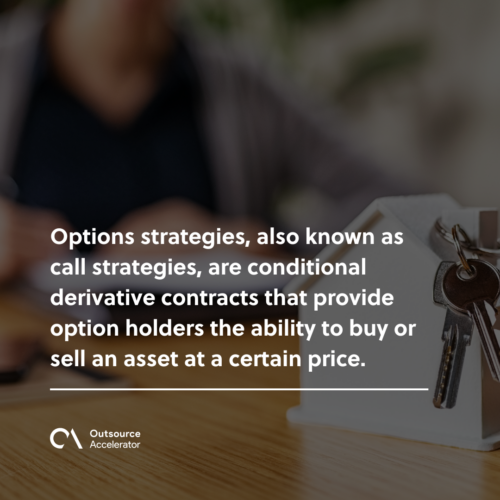Option Strategy
Definition
What is an option strategy?
Options strategies, also known as call strategies, are conditional derivative contracts that provide option holders the ability to buy or sell an asset at a certain price.
Option purchasers are compensated by the sellers in exchange for providing options. If market prices are unfavorable, option holders will let the option expire worthless, guaranteeing that their losses do not exceed the premium version of their purchase.
Option sellers, on the other hand, take on more risk than option purchasers, which is why they want a higher premium.

2 Types of options
Call
A call option gives the contract buyer the right to buy the underlying asset at a fixed price in the future.
Put
A put option gives the buyer the right to upsell the underlying asset at a preset price in the future.
The options market, which trades contracts based on securities, is where you buy and sell options. Call options can be purchased through a brokerage company.
5 Strategies for using call options
Many traders who want to take their dealings to the next level turn to options trading.
Option strategy may be an excellent strategy to guard against the downside of trading, increase capital control while lowering risks or devise a speculative risk.
Here are the five most common call option strategies:
The long call
A long call is typically a call option strategy that bets on the underlying stock increasing in value before the expiration date.
It doesn’t get any simpler than the long call strategy, as it is one of the most common call option strategies for a trader.
When you buy a long call option, you’re betting that the stock’s price will rise, allowing you to benefit from your contract by exercising your right to gain the shares.
The covered call
The covered call strategy is a popular way for investors to maximize prospective gains on stocks already in their portfolios.
Selling call options on a stock, you already own is how this involves.
The objective is to make money through the call option premium while also earning from the stock’s rise.
Investors who are still positive on stocks might use covered calls as short-term insurance.
Bull call spread
Traders that use the bull call spread strategy buy call options at a certain strike price and expiry date. They then sell the same amount of call options at a higher strike price for the same date.
The objective behind the approach is to lower the overall cost of the trade by selling call options at a higher strike price.
The strategy’s disadvantage is that the strategy’s benefit is limited at the strike price of the sold options.
Bear call spread
Buying call options with a high strike price and then selling the same quantity of call options with a considerably lower strike price for the same expiration date is known as a bear call spread strategy.
The calls bought at a lower strike price will always generate more revenue than the contracts received at a higher strike price when you start the transaction.
If the underlying stock’s share price falls below the strike price of the calls sold, you keep the money.
If the stock rises in value, the call options purchased will reduce the stock’s upside risk.
Long call butterfly
A long call butterfly strategy can be the most effective call option method to use. You make a huge bet on a stock at a low price if you have a particular price target for a stock and a specific date in mind for a transaction.
When you sell two call options with a strike price, it’s equal to your stock’s target price to start a long call butterfly trade.
Then, at a lower strike price, purchase a call option and sell a call option at a higher strike price.
In an ideal scenario, the stock will reach the target price. All call options sold will expire worthless, while the lone call option acquired will benefit.
If the stock trades to exactly the strike price of the pair of call options initially sold, the long call butterfly produces the most profit.







 Independent
Independent




